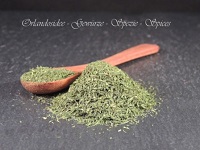
Dill
Anethum graveolens — delicate anise-parsley aroma
Dill (sometimes called “cucumber herb”) is a classic member of the Apiaceae family. Its feathery leaves add a mild, sweet anise note with fresh green brightness. Perfect for cucumbers, fish, rice, beans, spinach and egg dishes, as well as creamy sauces and marinades.
- Botany: Anethum graveolens • Family: Apiaceae
- Part used: leaves (“dill weed”), dried and cut
- Profile: gentle anise, parsley-like freshness, soft sweetness
- Best for: pickles, fish, potatoes, eggs, yogurt sauces, salads, light soups
Aroma & Taste
Delicate and green with cool anise tones. Dried dill is subtle and heat-sensitive—add late to keep its perfume vivid.
Culinary Uses
- Cucumbers & pickles: fold into cucumber salads; add to quick brines.
- Fish & seafood: finish salmon, trout or shrimp with lemon-dill butter or yogurt sauce.
- Eggs & dairy: omelettes, deviled eggs, cream cheese spreads, tzatziki-style dips.
- Vegetables & grains: potatoes, carrots, peas, rice and barley salads.
- Soups & sauces: add off-heat to light soups and cream sauces for a fresh lift.
How to Use
- Timing: stir in during the last 1–5 minutes of cooking or sprinkle at the table.
- Rehydrate (optional): soak 5 minutes in cool water, milk or yogurt; drain well.
- Fresh ↔ dried guide: about 1 tsp dried ≈ 1 Tbsp fresh.
Dosage & Kitchen Ratios
- Soups/sauces: 1–2 tsp dried per 1 l (4 cups) base, added off-heat.
- Dips/dressings (250 g/ml base): 1–2 tsp dried, plus lemon and salt to taste.
- Fish/eggs/veg: 1 tsp dried per 500 g (1.1 lb) food, then adjust.
- Quick pickles: 1–2 tsp dried per 500 ml (2 cups) brine.
Pairings
Lemon zest/juice, garlic, onion, chives, parsley; yogurt, sour cream, butter; potatoes, cucumbers, peas; salmon, trout, shrimp; rice and barley.
Ingredients & Allergens
Ingredients: Dill weed (leaves) — Anethum graveolens, dried.
Allergens: none mandatory in EN labeling for this single ingredient.
Storage & Shelf Life
Store airtight, cool, dry and away from light. Best aroma within 12–18 months. Reseal promptly after use.
Substitutes & Notes
Closest swaps: chervil (milder), fennel fronds (sweeter), or parsley with a pinch of lemon zest. Start small—dill’s gentle aroma can be overwhelmed by long cooking.
FAQ
Can I cook dried dill?
Yes, but add late—prolonged heat mutes its aroma.
Is dill the same as dill seed?
No—leaves are mild and herbal; seeds are stronger, toasty and used for pickling and breads.
How much dried equals fresh?
About 1 teaspoon dried = 1 tablespoon fresh; adjust to taste.
Merchant contact: Orlandosidee — Spice Shop (see site imprint for full company details). Email: info(at)orlandosidee.de



